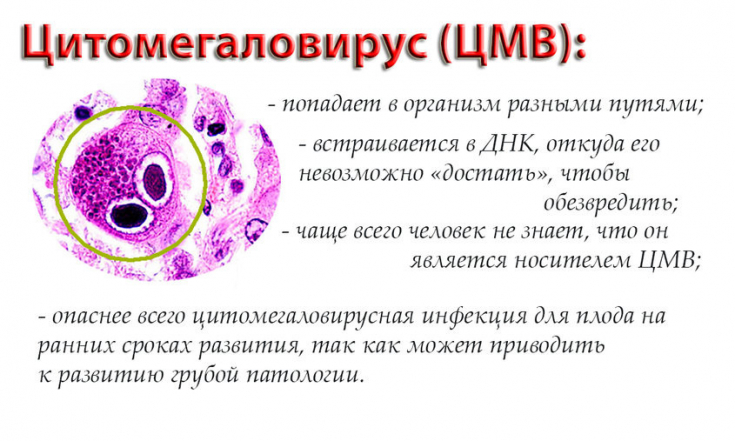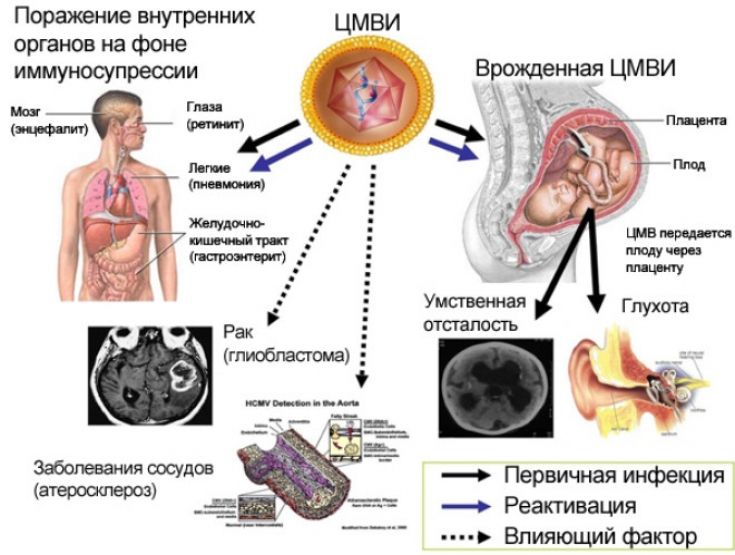Cytomegalovirus (CMV) − a virus of the beta-herpesvirus subfamily, which contains double-stranded linear DNA. CMV infection is widespread and affects most people. In immunocompetent individuals during a primary infection with this virus, the body's reaction is usually asymptomatic.
A virus of the cytomegalovirus family is capable of causing a lifelong latent infection with periodic subclinical reactivation. In immunosuppressed patients (particularly people living with HIV), CMV reactivation may be accompanied by a generalized infection that affects the eyes (chorioretinitis), the brain (encephalitis), the lungs (pneumonia), and the stomach and intestines (gastritis, enteritis, colitis). ) etc.
This publication on estet-portal.com highlights a modern view of the treatment of patients with cytomegalovirus infection, based on international recommendations and postulates of evidence-based medicine.
Ganciclovir: application features
This intravenous drug is the drug of choice in the treatment of patients with cytomegalovirus infection. Ganciclovir, under the influence of the viral enzyme protein kinase, undergoes a change in cells infected with cytomegalovirus. As a result, a phosphorylated form is formed and after a chain of changes, – ganciclovir triphosphate, which has a pronounced activity against this virus.
Follow us on Instagram!
The latter is incorporated into the virus genome and inhibits its further synthesis. Thus, the viral protein kinase UL97 is an integral component of the virus-static action of ganciclovir. Mutation of the gene encoding protein kinase UL97 is one of the main mechanisms for the development of CMV resistance to ganciclovir. There are many representatives of cytomegaloviruses and their subtypes sensitive to this drug.
It must be taken into account that famciclovir, penciclovir and aciclovir have greater antiviral activity against zoster virus (VZV) and herpes simplex virus (HSV) than ganciclovir.

With ganciclovir, the main side effects are fever, rash, diarrhea, and hematological toxicity (anemia, neutropenia, thrombocytopenia). The management of ganciclovir-induced neutropenia is to reduce the dose of ganciclovir and / or add growth factors (granulocyte colony-stimulating factor G-CSF, granulocyte-macrophage colony-stimulating factor GM-CSF) to the treatment.
This drug in tablet form is characterized by poor absorption in the gastrointestinal tract, therefore, a less optimal form for the treatment of patients with active cytomegalovirus infection.
Ganciclovir use in patients with complications
In the treatment of patients with pneumonia caused by cytomegalovirus, the simultaneous administration of this drug and CMV-specific immunoglobulin is recommended. It has not yet been established how the additional use of immunoglobulins in patients with CMV pneumonia improves the prognosis.
What to watch out for: the specifics of the course of tularemia
Ganciclovir is recommended for use in cases of diarrhea associated with CMV colitis and enteritis in people living with HIV infection (after biopsy and confirmation of the CMV etiology of diarrhea). Given the high risk of relapse in immunosuppressed patients, all people living with HIV should be offered maintenance treatment after completion of the main (induction) phase.

For the treatment of cytomegalovirus retinitis, esophagitis, or colitis in people living with HIV infection, ganciclovir is given at a dose of 5 mg/kg every 12 hours. The duration of the induction phase is 14-21 days for CMV retinitis and 21-42 days for CMV - esophagitis / colitis. In the future, the patient should receive secondary prophylaxis for 3-6 months until the level of CD4 increases > 100 cells / µl. Valganciclovir (900 mg single dose) is now more commonly used in secondary prevention for CMV retinitis than ganciclovir.
The lymphatic system: guarding the whole organism
Ganciclovir outside the hospital provides (secondary prevention of CMV infection) the need to monitor the parameters of the complete blood count as prescribed by the attending physician (monitoring of hematological toxicity of ganciclovir). It is also required to ensure regular (once every 3 months) examination by an ophthalmologist.
Primary syphilis: attention to lymph nodes
Ganciclovir and its analogues
An analogue of the drug ganciclovir is a tablet form for oral administration of the drug valganciclovir. It exhibits good absorption capacity in the human body and is metabolized in the liver.
To date, there are no recorded data comparing the effectiveness of ganciclovir and valgaciclovir as a secondary prevention of cytomegalovirus infection, however, given their pharmacokinetics, they should be equally effective. The dose of 900 mg/day is the prophylactic dose of valgaciclovir, therapy can last from 3 to 6 months depending on the activity of the process.
Foot fungus: main symptoms and prevention
Prevention of cytomegalovirus infection
Modern infectology provides for a sufficiently large number of drugs to prevent the recurrence of cytomegalovirus. These are drugs such as acyclovir, valaciclovir, famciclovir.
The doses of these antiviral drugs are standard, and for risk groups (immunosuppression, condition after transplanted organs, immunodeficiency states) is selected individually. In the course of studies aimed at studying the effectiveness of acyclovir, it was found that its effectiveness is lower in comparison with ganciclovir, since a very small part of the viruses turned out to be sensitive to it.
Thus, ganciclovir and valganciclovir are the drugs of choice in the treatment of patients with CMV infection and are used for secondary prevention in immunocompromised patients.
Infectious mononucleosis: modern methods of diagnosing the disease







Add a comment